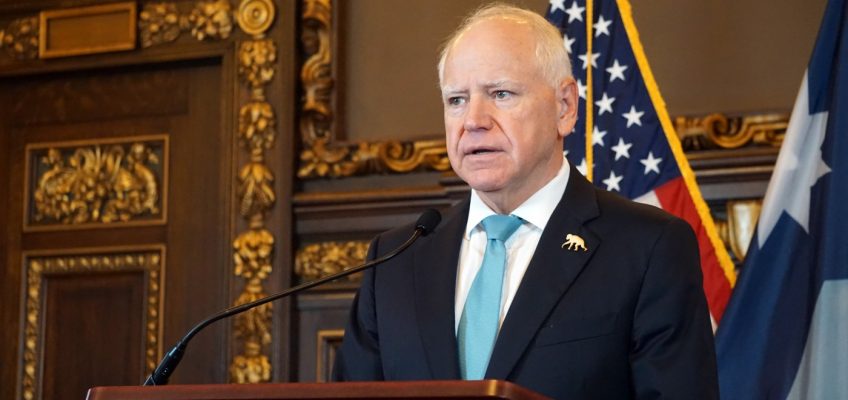Some federal assistance programs could run out of funding if a government shutdown that started Oct. 1 drags on into next month, Minnesota’s top budget official said on Thursday.
State Budget Director Ahna Minge explains the potential effects of a federal government shutdown on Minnesota during a briefing with Gov. Tim Walz at the state Capitol in St. Paul on Thursday, Oct. 2, 2025. (Alex Derosier / Pioneer Press)
But for now, most of the effects of the shutdown on the state are yet to be seen, including the cost to the state and the number of federal workers who will be furloughed or lose their jobs, according to Minnesota Budget Director Ahna Minge.
“Our current analysis is that the lapse in federal funds will have minimal impact on federally funded state activities in the short term,” she told reporters during a briefing at the state Capitol with Gov. Tim Walz.
“Most state programs have funding remaining from previous funding authorizations,” she continued. “But what we know is that the longer a shutdown lasts, the greater the impact.”
Food benefits
Food assistance benefit programs should have funding through October, Minge said, but if the shutdown extends into November, two major programs could run out of money.
SNAP — the Supplemental Nutrition Assistance Program, which used to be known as food stamps — and the Special Supplemental Nutrition Program for Women and Children, also known as WIC, might have funding problems in the event of a protracted shutdown.
Head Start — which provides pre-kindergarten education and other support to children from low-income families — could also see problems if the shutdown persists. Though most Head Start programs are funded annually.
A partial government shutdown in late 2018 and early 2019 lasted 35 days, though food assistance was not interrupted.
Around three weeks into that shutdown, airport security saw disruptions as Transportation Security Administration staff, who were working without pay, started calling in sick and quitting their jobs.
Failure to reach deal
This year’s shutdown comes after President Donald Trump and Democrats failed to reach a deal this week on funding the government.
Congressional Democrats seeking to preserve soon-to-expire health insurance subsidies for millions of Americans declined to support a Republican measure to fund the government through most of November. GOP leaders say keeping the subsidies would cost more than $1 trillion.
Until they can reach an agreement on funding the government, around 750,000 federal employees are set to be temporarily furloughed, according to the Congressional Budget Office.
Vital government operations like the U.S. Postal Service, airport security, air traffic control, veterans’ health care and federal law enforcement continue to run. The shutdown has not interrupted Social Security, Medicare or Medicaid benefits — though temporary layoffs could lead to administrative backlog.
Jobs impact still unclear
Minnesota has more than 18,000 federal employees, not including the postal service or members of the military. Most of them work for the Department of Agriculture and the Department of Veterans Affairs, according to state and union officials.
Walz said Minnesota’s Department of Management and Budget had a team prepare for about four weeks in anticipation of a shutdown, which entered its second day on Thursday.
“There is a playbook, if you will, on how things start to roll back, what furloughs look like, what the impact is at this early stage,” the governor said.
Walz said a big concern was the closure of the agriculture department’s farm service offices, which can be busiest during the fall harvest season.
The state did not have an estimate Thursday of how many federal employees will be out of work.
Though as a shutdown approached its first month in 2019, around 6,000 federal workers were furloughed or working without pay in Minnesota, the Pioneer Press reported at the time.
‘Burden on state taxpayers’
The American Federation of Government Employees, a union that represents federal workers, is still trying to get a sense of how many employees are furloughed or working without pay, according to Ruark Hotopp, National Vice President for District 8, which includes Iowa, Minnesota, Nebraska, and the Dakotas.
Workers will get reimbursed for wages when the shutdown ends. During the shutdown, some may file for unemployment benefits with the Minnesota Department of Employment and Economic Development.
Around 1,000 federal employees had applied for benefits by around the third week of the 2018-2019 shutdown, DEED said at the time.
“Benefits are being granted through the state, and it’s not even an action of the state that caused the unemployment,” Hotopp said. “This becomes a burden on the state taxpayers.”
Local government disruptions?
There’s little indication so far that the shutdown has affected local government. A Ramsey County spokesman said no services have been interrupted.
The same is the case for the city of St. Paul, which “executed several key grant contracts in the last week” to prevent any gaps in funding, according to Mayor Melvin Carter spokesperson Jennifer Lor.
“Typically grant-funded work continues during a shutdown, and we expect to continue delivering core, essential city services to our residents,” she said in an email.
The same is the case for St. Paul Public Schools, as most K-12 spending is not immediately affected by a government shutdown.
This story contains information from the Associated Press.
Related Articles
DFL, GOP deadlocked in talks for special session on gun violence
Joe Soucheray: Trump had nothing to do with fraud in Minnesota. That’s on the governor.
Gov. Walz: GOP won’t budge on gun control; House speaker calls it ‘mischaracterization’
Former DFL lawmaker Nicole Mitchell sentenced to 6 months in jail for burglary
Why did two firefighters walk from Duluth to St. Paul? This is their story.


Leave a Reply